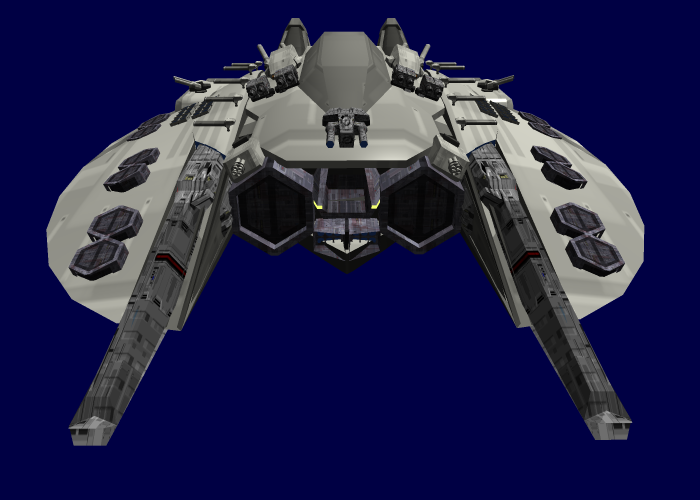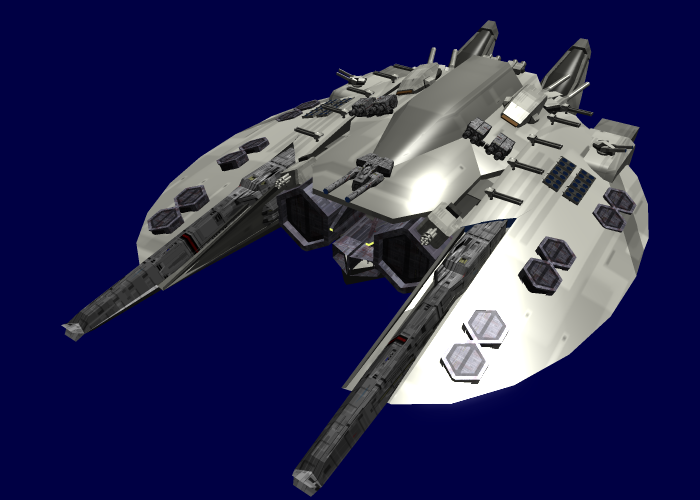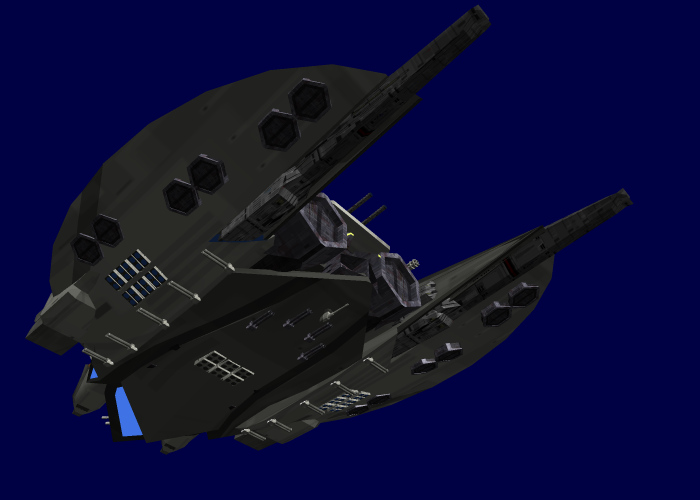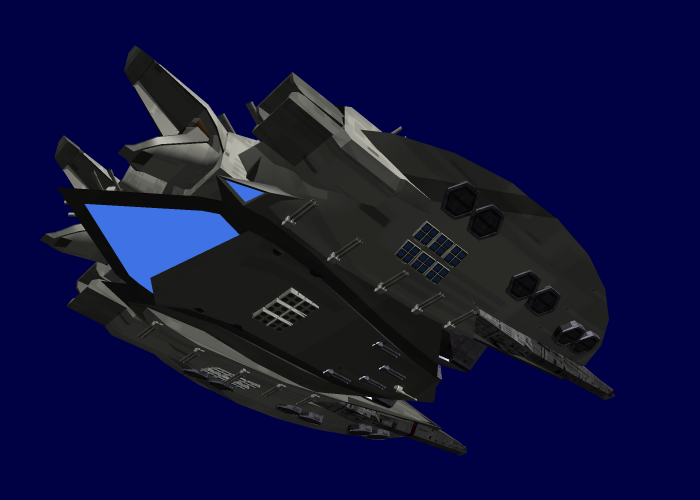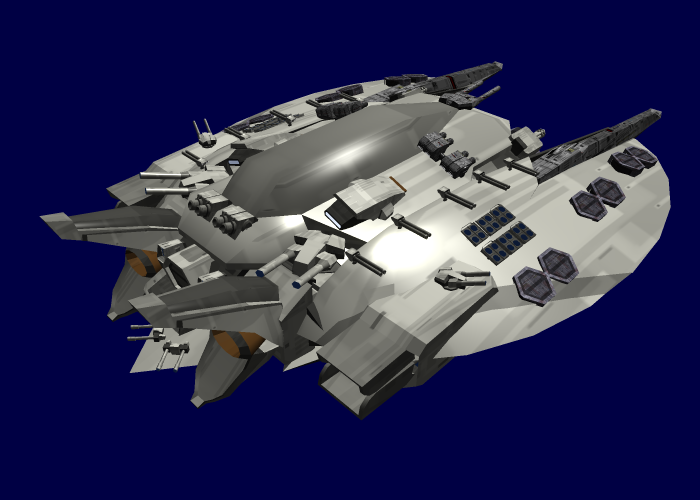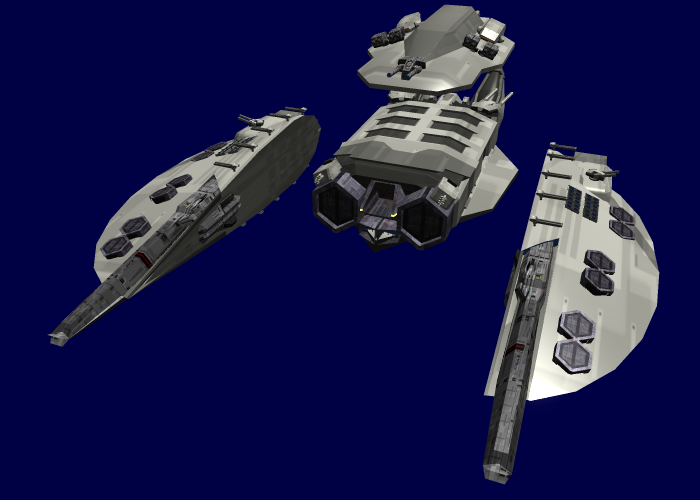Sidebar
Table of Contents
Eagle-Class Battle-carrier
In YE30 the Eagle-Class Battle-carrier has been designed to serve as the new backbone to the Lorath Matriarchy fleet, in late YE 32 it is expected to be fielded.
About the Ship
With recent developments in resource management and fleet allocations, the Lorath Matriarchy determined that an ideal method of conserving on the production of capital warships and permanent installations was to partially combine such costs in the form of one unit. This reasoning produced the Eagle-Class Battle Carrier for the purpose of serving as a forward support and rear support platform for fleet movements.
Key Features
The primary features of the Eagle-Class make themselves apparent at a glance. Size, carry-capacity, and weapon payloads are the primary features of the class.
Mission Specialization
The primary function of the Eagle-Class is to serve as a mobile command and deployment platform, while also delivering heavy supporting fire.
Specializations Of The Eagle-Class
- Heavy Fire Support
- Fleet Combat Operations
- Command And Control
- Small Craft Deployment Platform
- Planetary Siege
Appearance
History and Background
From the very start of the Matriarchy's relations with the outside universe beyond their home world in YE28, with the aggressive subjugation of Lor through the actions of the YSS Sakura under the command of Taisa Rufus Sydney, the Lorath have found themselves as the target of military driven diplomacy. From YE28 and onward, the Lorath have been involved in conflicts ranging from a disastrous run-in with the Sfrarabla Mishhuvurthyar Xhrafuklurp (SMX) to the subjugation of traitors to the Matriarchy. During these events, the Lorath Matriarchy had found that their space superiority was non-existent with threats posed by opposing spacecraft which could annihilate the Matriarchy within the span of a day.
Due to the threat posed by outside forces, the Matriarchy made its best attempts to raise a fleet which could effectively subdue enemy attackers, while ensuring the best of Lorath interests abroad. However, the Lorath Self Defense Force did not have a means available to deliver decisive firepower and support to front-line engagements in an economical manner. With fleet sizes reaching the very brim of what the Matriarchy could sustain in YE30, the decision was made to produce a new series of ships which would be able to deliver the will of the Matriarchy, while minimizing supply lines required to support the craft. Through these requirements, the Eagle-Class Battle-Carrier project was conceived, but was spurred onward by the involvement of High Priest Velor Tomoe Tur’lista, as a project which could also deliver a gift to the United Outer Colonies Prime Minister Tange-Katsura Ayana to commemorate the birth of her son. While using this motive and somewhat of a guise, the High Priest effectively transitioned the project to include the assets of the United Manufacturing Cooperative into the project.
Statistical Data
General
- Class: LM-FSB-BC-001 1)
- Type: Battle Carrier
- Designers: Lorath Matriarchy, Lorath Self Defense Force,United Manufacturing Cooperative, High Priest Velor Tomoe Tur’lista
- Manufacturer: Lorath Matriarchy, Lorath Shipyards and Affiliated Shipyards
- Production: Initial Production of five, Intended to be mass produced in relation to available star system resources.
- Fielded by: Lorath Matriarchy and authorized affiliates.
Cost: Each Eagle-Class Battle Carrier is counted as four Capital Ships due to the multi-section design incorporating four modules, each of which are counted as one ship.
Damage Ratings
| Hull Section | Damage Rating |
| Port Wing | 50 |
| Starboard Wing | 50 |
| Carrier Section | 50 |
| Command Module | 50 |
| Total | 200 |
Shields: 160, Threshold 5
Passengers
Active Crew:
- 15 Command Officer Staff
- 125 Sub-Command Staff
- 650 Operations Staff
- 600 Engineering Staff
- 750 Senior Pilots
- 2,500 Service Staff
- 2,500 Active Multi-Purpose Infantry
- Total: 7140 Active
Inactive Crew:
- 250,000 Cold Suspended Support Pilots
- 100,000 Cold Suspended Infantry Support
- 5,000 Cold Suspended Support Staff
- Total: 355,000 Stored Reserve
Maximum Capacity: 500,000 In Shipwide Cold Storage, 400,000 Active
Dimensions
- Length: 5,000 Meters
- Width: 4,375 Meters
- Height: 1,875 Meters
- Decks: 170 Primary Decks, 5 Meters Average Excluding Flight Decks and Utilities
- Secondary Decks2): 340 at 2.5 Meters Each On Average
Propulsion and Range
- Continuum Distortion Drive: 10,000c
- Enhanced Subspace Wave Drive: 15,000c
- Hyperspace Fold Drive: .6LY Min
- Sublight Engines: .25c
- Range: 2,000 LY
- Lifespan: 40+ Years
- Refit Cycle: Refitted when upgrades are available and in a suitable port
Inside the Ship
Due to the sheer volume and redundancies of the Eagle-Class, a full listing of compartment placements is not possible at this time.
Deck Layout
| Sections | Notable Features, Decks, Other Notes |
| Port and Starboard Wing Modules | Broadside weapon control, Infantry & Reserve Crew Quarters, Exterior System Monitoring & Operations, Secondary Hangars, Recreational Areas |
| Topside Central Operations Module | Primary Bridge (Deck 150), Officer's Quarters, Main Engineering, Primary System Control, Starship Hangar Operations. |
| Mid-Bottom Hangar Module | Wh'Ki Module Starship Hangars, Secondary Recreational Areas, Small Craft Flight Decks, Pilot and PA Infantry Quarters, XL and Interstellar Missile/Torpedo Bays |
Compartment Layouts
Command Compartments
Due to the size of the Eagle-Class, multiple command compartments have been installed upon the ship, and operate together to operate the ship at it's full capacity, or individually when it is best to do so.
Primary Command Compartment
One LSDF Standard Primary Bridge has been installed, which coordinates command operations between lower command compartments. This compartment is located in the upper command module of the Eagle, on deck 40.
Secondary Command Compartments
Eight LSDF Standard Secondary Bridge compartments have been distributed through the Eagle-Class, located on the middle-most decks of each section. These compartments are intended to handle the distribution of orders from the primary bridge, and to conduct independent command operations for their designated sections.
Tactical Command Compartments
Sixteen LSDF Standard Tactical Bridge compartments have been installed on the Eagle-Class, these compartments have been installed for the purpose of relaying command orders from the secondary and primary bridges to starship weapon firing crews and deployed infantry, as well as starship and small craft squadrons during combat operations.
Engineering Compartments
For proper operation of the Eagle-Class, multiple dedicated engineering compartments have been installed to allow for the operation, repair, and refit of systems aboard the starship.
Engineering Monitoring Stations
LSDF Engineering Monitoring Station compartments have been distributed through the Eagle-Class. Each of these compartments is used to oversee system operations in their respective areas, and conduct maintenance and repair upon the systems in their section. Engineering monitoring stations are also capable of coordinating with each-other to allow for efficient responses to technical failures or damage.
Core Monitoring Compartments
Due to the sheer bulk of the Eagle-Class, multiple LSDF Core Monitoring Station compartments have been distributed near engines, high-demand plasma reliant systems, and antimatter production facilities. These monitoring stations are used to regulate, control, and harness the various power sources used for the Eagle-class, and ensure the safe operation of these systems, as well as conduct emergency response procedures in the event of a power core failure.
Engineering Testing Compartments
Thanks to the spacious interior area of the Eagle-Class, space has been allocated for the installation of several LSDF Engineering Testing Compartment for general R&D, as well as the development and testing of new systems to be deployed upon the Eagle itself.
Engineering Manufacturing Compartment
Due to the sheer bulk of the Eagle, the number of systems, and the needs of the crew aboard the ship, twenty LSDF Engineering Manufacturing Compartment have been installed to facilitate supplying the ship with equipment, various material supplies, and replacement parts.
Engineering Utility Access and Monitoring
LSDF Engineering Utility Access and Monitoring compartments have been distributed throughout the Eagle to ensure the smooth operation of the utility systems of the ship, and to conduct maintenance and repair of such systems.
Armories
Heavy Armory
Four LSDF Heavy Armory compartments have been distributed through the Eagle-Class, each of these armories being built in the Extra Large configuration. These armories serve to provide equipment, supplies, and munitions to ship security personnel, deploying infantry, power armor units, and ships which are in need of resupply.
Secondary Armory
Ten LSDF Large Secondary Armory compartments have been distributed throughout the Eagle-Class, and serve as a secondary source of supplies and equipment to suppliment the heavy armory stores.
Weapon Locker Rooms
LSDF Weapon Locker Room are placed in sections of the Eagle essential to operations, and serve as a location in which arms can be supplied to personnel on duty..
Small Munition Magazines
LSDF Small Munition Magazine have been installed in various locations throughout the Eagle-Class to provide small arms ammunition to armories for restocking purposes, as well as serving as a restocking location in the event of a long-term in-ship engagement.
Emergency Armories
LSDF Emergency Armory rooms are located in essential compartments such as the bridge, engineering monitoring rooms, medical bays, and other such locations.
Crew Quarters
Eagle-Class starships include the following configurations of crew quarters;
Due to the large population of the Eagle-Class, combined with the large area of the ship, crew quarters have been distributed through the ship, and have been arranged in clusters that are encouraged to function as small communities. Though, some smaller crew quarter compartments have been installed adjacent to essential locations, these quarters are often reserved for specialist personnel who are often on call. Commanding officer quarters are located adjacent to the bridge.
Latrines, Toilets, Restrooms
Placed throughout the Eagle-class are various forms of waste management for crew waste disposal, the following compartments are included in the Eagle-Class' design;
While there are many waste disposal compartments distributed through the Eagle for convenience, most often these compartments can be found adjacent to work areas such as engineering monitoring areas and command compartments.
Baths
Bathing compartments have been installed aboard the Eagle and are placed near crew quarters, though, additional showering compartments can be found near work areas in which personnel are exposed to materials in which crew may desire to wash from their persons, while the commander's bath has been placed adjacent to the commander's quarters. Eagle-Class starships include the following bathing compartments;
Galley
Eagle-Class starships have a sizable crew, thus requiring a corresponding number of galley compartments for the preparation and distribution of food. Galley compartments are distributed throughout the ship, and have mainly been placed adjacent to crew quarters, recreational areas, and densely populated crew-served work areas, since all of such areas include a mess area. Eagle-class ships include the following galley configurations;
Mess
Much as the demand for galley compartments remains an aknowleged need, mess areas for the consumption of food also are a key part of the Eagle-Class' creature comforts. Mess areas have been designed to serve various crew sizes, and sizes of mess areas to be installed in locations have been placed according to the population of a given location of the Eagle-class in relation to work crews, and personnel which have quarters in the area. Eagle-class ships include the following mess compartments;
Ready Room
Due to the intended purpose of the Eagle-class being that of a warship, numerous Ready Rooms have been installed for the purpose of properly preparing personnel for their intended duties, assignments, and deployments. Ready rooms are essentially rooms in which personnel are instructed as to the specifics of a given mission, operation, theater of operations, or given other information relating to their assignment. Due to the various scales of operations in which the Eagle-Class conducts, various ready rooms have been installed, which include the following;
Wardroom
A key part of Lorath culture are the social bonds formed during service, this cultural point has not been overlooked in the design of the Eagle-Class. Wardrooms have been installed upon the Eagle-Class, these areas have been designated as social meeting places in which enlisted personnel, officers, and mixed portions of the crew can meet for duties not related to the operations of the ship, or other similar duties. Wardroom designs incorporated in the Eagle-Class design include;
Cargo Holds
Due to the sheer scale of logistics that is involved in merely operating the Eagle, along with the logistics of deploying starships and personnel, cargo holds are an essential part of the operation of the Eagle-Class. Due to the sheer volume and variety in which the Eagle's cargo holds are expected to hold, a wide range of cargo hold sizes and types have been incorporated into the design of the Eagle-Class, including the following;
It should be noted that the 'Secret Cargo Hold' in the application of the Eagle-Class is intended to be used at the discretion of the Eagle's commanding officer for the storage of what he or she deems fit.
Utilities
Serving as a backbone to the Eagle-Class, utility systems are a key component, and rely upon the various utility access points, monitoring rooms, and simmilar compartments which are scattered throughout the Eagle-Class. Eagle-Class ships include the following utility compartments;
Lockers
Even on a military ran starship such as an Eagle-Class, securing personal belongings is something which is on the mind of personnel, along with the securing of equipment and supplies which have been issued to a specific individual. Due to this need for security of individual property or equipment, locker rooms have been installed upon the Eagle-Class, which include;
Cryonic Support
A key facet of Lorath military might, cryonic storage capabilities provide the Eagle-Class with a sizable compliment of support personnel kept in cryonic hibernation until needed. Cryonic support compartments are areas in which cryogenic preserved individuals are stored until needed. Cryonic support is in the following design;
Computer Control
Due to the sheer technological requirements that the Eagle-Class possesses, computer control systems are an essential component. Computer control compartments allow for authorized personnel to have access to computer systems, and to conduct computer maintenance. Computer control compartments range from direct computer access, to simple low-security and low-access user terminals. Computer control compartments include the following variations;
Arms Loading & Munitions Handling
Due to the Eagle-Class being a military starship, and a combat starship, weapon systems are a key concern of the starship. Fueling the weapons of the Eagle-Class are arms loading and munitions handling rooms which serve as magazines for power cells, solid munitions, and even antimatter. These compartments remain secure, while ensuring the security of the ship, these compartments include the following variations and varieties;
Vehicle Utilities
Since the Eagle-Class has been developed in part as a carrier, vehicle utilities are a key system of the class. Vehicle utility compartments provide support to vehicle launching functions of the Eagle-Class, as well as operation functions and other related tasks. Vehicle utility compartments include;
Launch Bays
Launch bays make the Eagle-Class what it is, a battle-carrier. A variety of launch bays have been installed upon the Eagle-Class to provide the ship with the capacity to launch vehicles ranging from full-size starships, to swarms of infantry power-armor. Eagle-Class starships include the following launch bay compartments;
Notably, the Eagle-Class has been outfitted with two 'Massive Launch Bays', as well as a single centrally located and integrated launch bay. These three bays serve as the starship launching platform for the Eagle-Class. Numerous other launch bays have also been included which handle lesser operations such as fighter launches, power armor launches, and large mechanical unit launches.
Raptor-Class Bays
Optimizing the capacity of the Eagle-Class, a series of specialized docking bays have been included. These docking bays are designed exclusively for the Raptor-Class Expeditionary Ship. Designed with the Raptor's unique shape in mind, these launch bays have been integrated into the 'wing' sections of the Eagle-Class, along the edges of their structures, and have been placed behind shutters. Each Raptor-Class bay includes robotic manipulator arms for ship repairs, docking ports, and lift-bridges which allow for rapid transport of personnel and materials between the battle carrier and their payload of Raptor-Class.
A total of fifty Raptor-Class bays have been integrated into the Eagle-Class, with one Raptor-Class assigned per bay.
Quartermaster
One of the most essential compartments in relation to personnel operations aboard the Eagle-Class is the quartermaster offices. These compartments have been designed for the purpose of the storage and distribution of equipment for personnel serving aboard the Eagle-Class starship, as well as for distributing equipment and supplies to starships docked to the Eagle-Class. Quartermaster compartments aboard the Eagle-Class include;
Aid Compartments
Due to the sheer size of the Eagle-Class, areas in which personnel can receive assistance in the event of injury, illness, or exhaustion became a practicality. These compartments have been designed to provide a location in which personnel can rest in the event of exhaustion, or can receive minor medical assistance. Aid compartments include these two variations;
Medical
An essential compartment for a manned starship, medical compartments provide long and short term medical services to personnel assigned to the Eagle-Class, as well as for personnel passing through the starship. Eagle-Class starships include the following varieties of medical compartment;
Notably, medical compartments can be found adjacent to areas in which infantry and other combat return to the Eagle-Class after deployment. Additionally, it should be noted that medical compartments include additional sub-compartments within their spaces.
Science
Since the Eagle-Class provides an extensive quantity of space for various functions, science compartments have been included for the purpose of R&D, and conducting research into phenomena which may be encountered by the Eagle-Class, or starships launched from it. Science compartments aboard the Eagle-Class include the following;
Security
An essential part of a military starship, or any large ship in general, security compartments provide security personnel with locations in an Eagle-Class starship in which they can coordinate, and conduct operations from. Security compartments in Eagle-Class starships include;
Recreational
To Be Added
Multi-Purpose
To Be Added
Elevators/Lifts
To Be Added
Ship Systems
Armored Hull and Hull Integrated Systems
Hull
Eagle-Class battle-carriers have been designed to include a hull composed of layers of material, which have been installed to provide optimal protection in relation to materials utilized. Materials used in the construction of the Eagle-Class' hull include;
- Boron-Carbide
Eagle-Class hulls employ their armor materials by utilizing an external layer of Duremium plating, followed by a backing of a thinner Nerimium plating, with a Durandium layer beneath, with a layer of 'Stone thread' beneath to serve as insulation, with a layer of boron carbide beneath, and finishing off with a Durandium interior hull layer.
Hull Support Systems
Ablative Armor Projection System
Eagle-Class Battle-Carriers include a Ablative Armor Projection System, this system provides the capacity to create expendable hull layers, and other such metallic projections upon the hull of the Eagle-Class.
Structural Forcefields
Aiding in the durability of the Eagle-Class, conformal electromagnetic and gravitic shield generators have been integrated throughout the hull of the ship to be utilized as forcefield projectors, instead of defensive shield projectors. These forcefields are utilized to deflect small debris, maintain structural integrity, and temporarily patch hull breaches to prevent decompression or structural break-up.
Shielding Systems
Eagle-Class ships have been built to include several different shielding technologies which have been applied to optimize the Eagle-Class' defensive versatility, thus allowing the Eagle-Class to defend against a wider range of threats. Shield systems included in the Eagle-Class' design include;
Computers and Electronics
Eagle-Class battle-carriers have been designed to incorporate a number of various computing platforms, and hardware, to provide an optimal range of computing capability. Technologies ranging from synthetic intelligence to quantum computing platforms have been utilized to provide the Eagle-Class with the capacity to operate its own systems, as well as coordinate and augment the computing and communications of a sizable portion of a fleet.
- Neural Processor Pack
It should be noted that Eagle-Class starships maintain a sizable compliment of ARIA units on-hand for the purpose of replacing units on starships which are to be serviced by the Eagle-Class, or to assist in coordinating functions aboard the Eagle-Class, these individual ARIA are not counted in the ship's compliment of crew however, since they are classified as equipment.
Communications
In conjunction with the Eagle-Class' computer systems, the Eagle's communications systems have been designed to allow for the Eagle to transmit and receive data, while coordinating and providing information to ships connected to the Eagle-Class. Eagle-Class battle-carriers utilize MIKO Electronics Suite integrated communication features, as well as Lorath Communications Systems. It should be noted that communications in, out, and within an Eagle-Class starship are processed through a trio of dedicated 'Operator' ARIA which filter out anomalous data packages, and optimize data package flow.
Emergency Systems
In the event of emergency, the Eagle-Class battle-carrier has been outfitted with the following integrated safety systems.
Isolation Doors
Forcefield-Nested Isolation Doors have been included to provide the capacity to quickly seal off areas of the Eagle-Class which are critically damaged, or to isolate areas of the Eagle from pathogens, harmful containment breaches, intruders, and similar potential threats to crew and ship safety.
Containment Systems
Much like the isolation door system, a containment system has been integrated into the Eagle-Class which uses Lorath shield technology to project forcefields on, in, or over hatch-ways, doors, corridors, conduits, vents, and various other locations to provide the capacity to snuff out fires, contain harmful materials, and to prevent unauthorized access to portions of the Eagle-Class Battle-carrier. Containment system control is coordinated by ARIA units in conjunction with authorized crew members assigned to the Eagle-Class.
Medical Drones
Eagle-Class battle-carriers include emergency in-ship dispensers for Remote Medical Drones for the purpose of providing emergency medical aid throughout the ship when trained medical personnel are unavailable. Additional drone launchers are included on various exterior points of the Eagle for the purpose of providing medical aid to external work-crews and other personnel.
Pathogen and Harmful Material Cleansing Systems
Located in utility rooms, vents, waste treatment ducts, and other simmilar locations. Pathogen cleansing systems involve the use of Lorath Plasma Arc Disruptor vent strips to introduce heated plasma to incinerate harmful chemicals or pathogens from the utility systems of the Eagle-Class, additionally, the use of specialized active nanomachines which can be introduced for the purpose of selective pathogen removal when plasma systems are unavailable, or impractical for the neutralization of such contaminants.
Emergency Life Support
M37/38 Environmental Battledress Uniform are kept widely available aboard the Eagle-Class in the event of the failure of systems related to the production of atmosphere, as well as in the event of the presence of harmful materials.
Escape Systems
Harbinger-Series Drop Pod units have been integrated into the Eagle's design for the purpose of being used as escape pods, as well as Journey-Class Shuttle units for command personnel, as well as critical ARIA units. Harbinger and Journey-Class shuttle units are kept in a series of launch channels which span the interior of the Eagle-Class, and allow for the launch of escape vehicles from deep in the interior of the Eagle-Class. Escape launch tubes are forcefield shielded and kept in a locked-down state until orders to abandon ship are issued from the Eagle-Class' commanding personnel.
| Note: Vehicles intended for escape purposes are not counted in vehicle manifest numbers. |
Cryonic support compartments within the Eagle-Class are capable of conducting the controlled jettisoning of stored personnel in the event of a catastrophic system failure or the eminent destruction of the ship. In this situation, personnel storage pods are ejected through escape ports, and are sustained through the use of an emergency support system which would maintain the function of individual cryonic storage pods until the pods can be retrieved.
Life Support Systems
Water
For the purpose of providing water for crew consumption aboard the Eagle-Class, a hydrogen collection system specificly intended for the task has been integrated into the exterior of the Eagle-Class for the purpose of combining the hydrogen with oxygen to produce water.
Used water is processed through a system designed to operate similar to that of the SDI Water Filtration Device. Additional ozone based, polymer membrane, reverse osmosis, ultraviolet exposure, and steam treatment of water is utilized to ensure that water available on the Eagle is free of contaminants. Biologically contaminated waste water is often treated in a manner which allows for waste material to be routed to various utility systems such as bacterial power cells, and chemical separation facilities.
Air
Air aboard the Eagle-Class is largely recycled from an initial storage capacity. Air is recycled through the use of plant and bacteria based filtering devices. Air is further purified through the use of polymer membranes, as well as a process of being routed along systems of the Eagle-Class which produce exceptionally high heat levels for the purpose of neutralizing airborne pathogens.
In the event of requiring replacement air, the Eagle-Class' life support system is capable of routing water from the Eagle's water supply into a holding tank, where it is then subjected to electrical current to separate oxygen from hydrogen. Nitrogen is derived from waste processing procedures.
Life Support System Secondary Power
For the purpose of conserving power aboard the Eagle-Class battle-carrier, the ship's life support system has been designed to produce a portion of its own power. With this intent, water production systems aboard the Eagle are designed to conduct the combining of oxygen and hydrogen within a proton exchange based power cell. Additional power is derived through the use of Bacterial Charge Pack and methane produced from waste management procedures.
Combined Field System
Borrowing from their peers in the United Outer Colonies, as well as through the United Manufacturing Cooperative, the Eagle-Class has been outfitted with a Combined Field System. This system has been integrated for the purposes of secondary propulsion, secondary defense, sensor baffling, phase canceling, and as a weapon in circumstances in which the system would best serve in such a capacity. Usually, this system remains active in purely a defensive or propulsion capacity.
Propulsion
Eagle-Class starships utilize several methods of propulsion, including the previously mentioned CFS system. Propulsion systems included aboard the Eagle-Class include the following;
It should be noted, that due to the large quantity of thrust required to propel the Eagle-Class using typical Lorath thrusters, fusion based systems have been augmented to also utilize aether energy arcs to assist in the production of heated plasma for thrust.
Power System
Due to the hefty size and function of the Eagle-Class, power systems aboard the Eagle have been diversified for redundancy, and versatility. Power systems aboard the Eagle-Class include;
- QNC units.
Gravitic Manipulation Systems
Eagle-Class battle-carriers have been designed to include a number of gravitic manipulation systems beyond the gravitic shields which have been included in the shielding systems of the ship. These systems include graviton beam projector systems, gravity regulation systems, and inertial manipulation technology. It should be noted that graviton projectors have been distributed upon the exterior of the Eagle-Class to provide a full field of coverage to project graviton beams to tow or halt objects.
Psionic Scrambling Systems
Psionic Signal Controller and Psionics Scrambler Device technology has been included in the Eagle-Class' design for the purpose of preventing unauthorized psionic activity, and protecting the ship's crew from psionic assault.
Aether Dampening System
An Aether Dampening Field System has been included in the Eagle-Class, this system has been designed to hinder the function of aether systems. This system is often reserved for the purpose of disrupting the efficiency of aether reliant combatants.
Electron Countermeasures
Electron Countermeasure technology has been incorporated into the Eagle-Class, this system developed by the United Outer Colonies has been included for the purpose of disrupting the effectiveness of positron based weapon systems.
Pico-Jelly Circulation
For purposes professional and personal, a Pico-Jelly circulation system has been included as a standard utility aboard the Eagle-Class. This system allows for the delivery of pico-jelly from a series of reservoirs distributed through the Eagle. Pico-jelly is delivered by a dispenser system, or to systems which utilize pico-jelly for their function.
Cryonic Storage System
Incorporated into the LSDF Cryosupport Chambers, the cryonic storage system utilizes long standing technology utilized by the Lorath for the controlled preservation of live personnel for extended space travel while using minimal resources.
Infantry Operations Support Systems
Forced Docking Ports
For the purpose of seizing starships, a series of docking ports have been designed to incorporate a forced docking system. Forced docking systems use a reinforced docking tube with a plasma cutting system housed along the docking ring at the end of the unit, as well as mechanical appendages which are used to grasp onto a target hull. Each forced docking port includes a plasma wash system to prevent enemy combatants from entering the tube, as well as to clear personnel from the area in which the docking tube has attached. Once attached, the docking tube delivers a sealing ring of pico-jelly which is meant to prevent the loss of atmosphere from where the docking tube and target hull meet. Personnel are then able to proceed between ships.
Variable Hull Configuration
To provide a wider range of function for the Eagle-Class battle-carrier, the structure of the ship includes systems which allow for the Eagle-Class to separate its primary components to produce four different independently operating sections. When separated, these four sections include the port and starboard wing modules, central docking module, and the command modules of the Eagle. Each of these sections maintain a sustainable degree of function, allowing for portions of the Eagle-Class to survive in the event of crippling damage being sustained by any one given portion of the ship. This splitting also allows for the Eagle to coordinate maneuvers in which multiple platforms would prove more effective than a single joined unit.
Weapons Systems
| Note: It should be noted that the Trans-Aetheric Shock Array is a dual-purpose weapon system which can function as an aether shock array and transposition cannon. This system has been built into two large forward mounted structures which are capable of creating an arcing aether projection or transposition rift between them, or able to project such discharges independently. |
- Precision Aether Shock Array: 1, Tier 14
- Twin-Mount Sunfury Cannon Turrets: 7, Tier 14
- Dual-Configuration UMC-GRA-E-S001 'Gammatron'/ Combined Particle Cannon Twin-Barrel Turrets: 24, Damage Ratings; Antimatter: Tier 12, Heavy Anti-Starship, Plasma: Tier 11, Medium Anti-Starship, Gammatron: Tier 12, Heavy Anti-Starship
- Cruise-Size Missile Launch Tubes: 144, Warhead dependent
- Repeating Launcher System XL-Configuration: 24, Warhead dependent
- Repeating Launcher System L-Configuration: 48, Warhead dependent
- Broadside Gun Port Clusters: 24
| Broadside Gun Port Compliment | Units | Damage Rating |
| Precision Aether Shock Array | 2 | Tiers 13 |
| Kh-C2-W3000 'Sunfury' Cannon | 2 | Tiers 13 |
| UMC-GRA-E-S001 'Gammatron' | 2 | Tier 12, Heavy Anti-Starship |
| Combined Particle Cannon | 2 | Tier 12, Heavy Anti-Starship / 3 |
| Offensive Plasma Arc Cannon | 4 | Tier 11, Medium Anti-Starship |
| Xeneth Cannon | 2 | Tier 11, Medium Anti-Starship / 4 |
- 40 Inch Gatling Railgun Turrets : 2, Ammunition dependent
- Xeneth Cannon: 12, Tier 11, Medium Anti-Starship / 4
- Swarm Missile Launchers: 24, Tier 10, Light Anti-Starship / 3, or can be loaded with alternate missile payloads.
- Retractable Compressed Packet Rifle Dual-Mount Point Defense Turrets: 2000, Tier 5 / 4
- L-Mark-Two Gunports: 1000, Ammunition dependent
- Defensive Plasma Arc Vent Strips: 1000, Tier 10, Light Anti-Starship
- Quad-Mount Small Arm Turrets: 2000
| Quad-Mount Turret Mountable Weapons | Damage Rating |
| 'Deviance' Shotgun Gatling 8 Gauge Conversion | Ammunition Dependent |
| LSDF “Ek'yra” Railgun Service Rifle | Ammunition Dependent |
| LSDF “Hik'id” Plasma Assault Rifle | Tier 6 |
Vehicle Complement
Power Armor
- AMX-102 WINTER: 25,000
Large Mechanized Units
- Whirlwind: 75
- Maelstrom Armor System: 3,125
Shuttles
Fighters
- Hawk Fighter Bomber: 625
Starships
Permanent Assigned Payload
Drop Pods
Harbinger-Series Drop Pod: 2,500
Drones
Drones to be remote controlled by the Eagle-Class as support units.
Gallus-Class System Defense Drone: 5 Remote Medical Drones: 100,000 Remotely Controlled and SI AMX-101 WINTER: 37,500 I-Size Interstellar Travel Drone Missile: 5
Page Tools
Terms of Service - Privacy Policy

